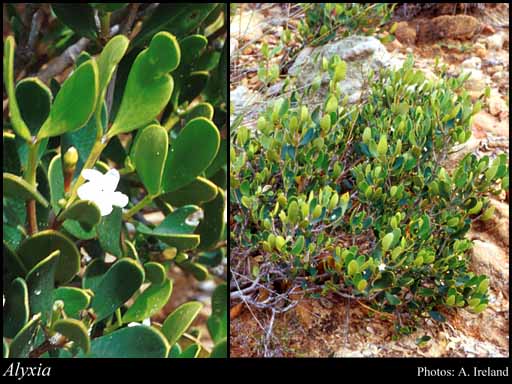- Reference
- Prodr.Fl.Nov.Holland. 469 (1810)
- Name Status
- Current

Scientific Description
Common name. Hop Bushes. Family Apocynaceae.
Habit and leaf form. Shrubs, or lianas; evergreen; laticiferous (white). Plants unarmed, or spiny (rarely). The spines foliar (lamina). Leaves cauline. To 2–5 m high (in shrubs). Self supporting, or climbing. Mesophytic. Not heterophyllous. Leaves small to medium-sized; opposite, or whorled; 3–6 per whorl; ‘herbaceous’, or leathery, or fleshy; petiolate; simple. Leaf blades dorsiventral; entire; linear, or ovate, or obovate, or elliptic; pinnately veined; cuneate at the base. Mature leaf blades adaxially glabrous, or pubescent (with basifixed trichomes); abaxially glabrous, or pubescent (with basifixed trichomes). Leaves without stipules. Leaf blade margins entire (or spinose). Leaf anatomy. Hairs present; glandular hairs absent. Unicellular hairs absent. Complex hairs present. Branched hairs absent. Complex hairs peltate.
Reproductive type, pollination. Fertile flowers hermaphrodite. Unisexual flowers absent. Plants hermaphrodite.
Inflorescence and flower features. Flowers aggregated in ‘inflorescences’. Inflorescence 1- many-flowered. Flowers in cymes, or in panicles. Inflorescences compound; axillary, or terminal (pseudo-terminal). Flowers pedicellate, or sessile; bracteate (floral bracts linear, ovate, triangular); small; fragrant. Hypogynous disk absent. Perianth with distinct calyx and corolla; 10; 2 -whorled; isomerous. Calyx present; 5; 1 -whorled; gamosepalous; lobed (lobes are deeply divided); lobulate. Calyx lobes markedly longer than the tube. Calyx erect; hairy; exceeded by the corolla; regular. Calyx lobes ovate, or obovate. Corolla present; 5; 1 -whorled; gamopetalous; lobed; lobulate. Corolla lobes markedly shorter than the tube. Corolla contorted (sinistrorse in bud); hypocrateriform (tube slightly swollen at area of stamen insertion); regular; hairy abaxially (with indumentum), or glabrous abaxially; hairy adaxially (with indumentum), or glabrous adaxially; plain; white, or cream (to creamy white). Corolla lobes ovate, or obovate. Androecial members definite in number. Androecium 5. Androecial members adnate (epipetalous); all equal; free of one another; 1 -whorled. Stamens 5. Staminal insertion in the throat of the corolla tube. Stamens all inserted at the same level; remaining included; all more or less similar in shape; isomerous with the perianth; oppositisepalous; all alternating with the corolla members. Filaments glabrous. Anthers all alike; dehiscing via longitudinal slits; introrse; appendaged. The anther appendages apical (short). Gynoecium 2 carpelled. The pistil 2 celled. Gynoecium syncarpous (the carpels united only by their styles); eu-syncarpous; superior. Ovary plurilocular; 2 locular. Gynoecium stylate. Styles 1. Stigmas 1; capitate. Placentation axile. Ovules 2–6 per locule (in 2 rows).
Fruit and seed features. Fruit 5–23 mm long (actually article length, each fruit has 1 to 5 articles); fleshy; yellow, or orange, or red, or black; indehiscent; a berry (1 or 2 berries, moniliform; each article globose to elliptical and 1-seeded); 1–5 seeded (1-seeded by abortion or 2–5 seeded). Seeds not compressed (ovoid, globose or ellipsoid-globose); not conspicuously hairy; wingless.
Geography, cytology, number of species. World distribution: Asia, Malesia, Melanesia and Australia. Native of Australia. Not endemic to Australia. Australian states and territories: Western Australia, South Australia, Northern Territory, Queensland, Victoria, and Tasmania. South-West Botanical Province. A genus of c. 120 species; 2 species in Western Australia; 0 endemic to Western Australia.
Additional comments. Etymology: from the Greek halusis (a chain) alluding to the fruit.
Etymology. From the Greek for "chain" and "fruit"; the pod is narrowed between the seeds.